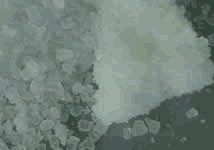

A water molecule consists of
one atom of oxygen and two atoms of hydrogen. We write the formula for
water as H2O.
Some other substances made of molecules include:
- oxygen gas(O2
)
- chlorine gas (Cl2)
- carbon dioxide(CO2)
- alcohol (C2H5OH)
Some substances have atoms as their smallest particles. Take salt for example. Salt is made from sodium and chlorine atoms packed together. There is one sodium atom for every chlorine atom. Look at the animation on the right.
Other substances that have
a similar structure to salt are:
- rust(Fe2O3)
- copper sulfate (CuSO4)

Structures that have atoms as their smallest particles rather than molecules tend to have metals in their formula. For example copper sulfate has the metal copper, while sodium chloride(salt) has the metal sodium. Some exceptions include diamond, graphite and silicon dioxide. The smallest particle of diamond and graphite is the carbon atom. Silicon dioxide can break up into silicon and oxygen atoms.
Complete the table below. You may need to look at chemical symbols before you start so that you can identify the metals and nonmetals.
|
Substance
|
Formula
|
Smallest particle (atom or molecule) |
|
Dry ice
|
CO2
|
|
|
Hydrochloric
acid
|
HCl
|
|
|
Sodium
hydrogen carbonate
|
NaHCO3
|
|
|
Ammonia
|
NH3
|
|
|
Aluminium
oxide
|
Al2O3
|
|
|
Magnesium
sulfate
|
MgSO4
|
|
|
Nitric
acid
|
HNO3
|
|
|
Copper
|
Cu
|
|
|
Copper
carbonate
|
CuCO3
|
|